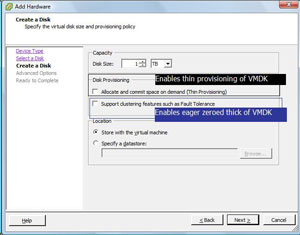vSphere Disk Provisioning
For VMware vSphere environments, there is more to provisioning a disk than simply choosing thick or thin. Within the vSphere Client we are not given all of the information on how the disks are provisioned when they are created.
The distinguishing factor among virtual disk formats is how data is zeroed out for the boundary of the virtual disk file. Zeroing out can be done either at run time (when the write happens to that area of the disk) or at the disk's creation time.
The VMDK format, VMware's virtual disk format, is used in three primary ways:
- Thin Provisioned Disk: The thin virtual disk format is perhaps the easier option to understand. This is simply an as-used consumption model. This disk format is not pre-written to disk and is not zeroed out until run time.
- Thick Provisioned Disk (Zeroed Thick): The Zeroed Thick option is the pre-allocation of the entire boundary of the VMDK disk when it is created. This is the traditional fully provisioned disk format that we would use in the VI Client in previous versions. In the vSphere Client, this is the default option.
- Thick Provisioned Disk (Eager Zeroed Thick): This pre-allocates the disk space as well as each block of the file being pre-zeroed within the VMDK. Because of the increased I/O requirement, this requires additional time to write out the VMDK. This is also the required format for the FT virtual machine feature with vSphere.
Within the vSphere Client, the thin provisioned VMDK and eager zeroed thick options are displayed by checking the appropriate box. If the default option is selected (no boxes chosen), the VMDK format will be Zeroed Thick (see Fig. 1).
 |
| Figure 1. Each VMDK option can be selected within the vSphere Client, including Zeroed Thick as the default format. (Click image to view larger version.) |
So, why is this important? For one, there may be a perceived performance implication of having the disks thin provisioned. The thin provisioning white paper by VMware explains with more detail how each of these formats are used, as well as a quantification of the performance differences of eager zeroed thick and other formats. The white paper states that the performance impact is negligible for thin provisioning, and in all situations the results are nearly indistinguishable.
Posted by Rick Vanover on 04/06/2010 at 12:47 PM